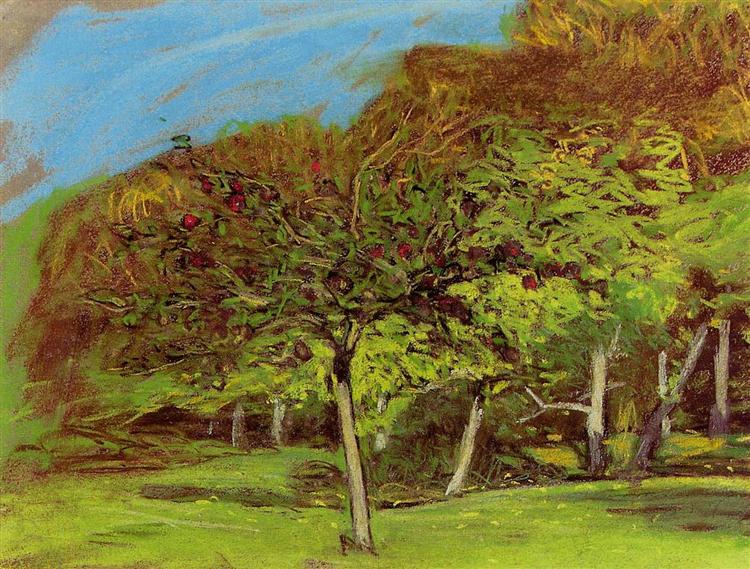Description
Claude Monet "Fruit Trees" painting, made in 1874, is a brilliant example of the impressionist style that revolutionized art in the nineteenth century. In this work, Monet captures the essence of spring through the representation of a landscape full of cherry trees in flower, where the delicacy of pink flowers contrasts gently with the green tones of foliage and soil. The composition seems to be influenced by the rhythm and cadence of nature itself, suggesting a fleeting moment that invites the viewer to savor the transitory beauty of the moment.
In terms of composition, Monet uses a slightly high perspective to establish an angle that highlights the sinuousness of the path that advances to the bottom. This winding path guides the viewer's gaze towards the center of the work, where fruit trees are grouped, creating a focal point that attracts and wraps. The delicate branches loaded with flowers seem to dance in the air, while the execution of the brushstrokes suggests an atmosphere of movement, as if the spring breeze gently shake the scene. This approach demonstrates Monet's ability to capture not only the image, but also the feeling of being present in that flourishing environment.
The color palette chosen by the artist plays a fundamental role in the creation of the emotional impact of painting. The soft and almost pink tones, combined with the freshness of light green and blue of the sky, evoke a feeling of joy and renewal. The light, characteristic in Monet's works, seems to be leaked through flowers, illuminating the scene with an ethereal effect that gives life to the composition. This interaction between light and color is one of the pillars of impressionism, and in "fruit trees", Monet demonstrates mastery in the capture of natural luminosity.
It is important to note that there are no visible human figures in this work, which reinforces the connection of the viewer with the natural landscape, allowing him to immerse himself completely in the scene. Without the distraction of the human figure, the focus is maintained in the interaction between natural elements and light.
In addition, "fruit trees" is in a period of personal and artistic discovery for Monet. In the mid -1870s, the artist was still finding his voice within impressionism, and this work is part of a series of explorations on the landscape and the flora of his surroundings. Monet, together with other contemporaries such as Pierre-Auguste Renoir and Alfred Sisley, began to cultivate a style that emphasized the capture of light and color immediately and quickly, different from the details of the academic art of its time.
The theme of flowering is recurrent in Monet's work, and this painting It can be compared to his famous "Garden in Giverny" that reflects his love for the garden and the landscapes that surrounded his home. Monet felt deeply connected to nature, and "fruit trees" is a testimony of his concern to translate the essence of flower cherry trees through their unique pictorial approach.
In summary, "fruit trees - 1874" is a work that not only captures a beautiful spring moment, but also reflects the evolution of the impressionist style and the affinity of Monet for the ephemeral beauty of nature. The spectator connection with this landscape, the masterful use of color and light, as well as the complexity of the composition, make this painting a jewel that continues to resonate in the contemporary artistic panorama.
KUADROS ©, a famous paint on your wall.
Hand-made oil painting reproductions, with the quality of professional artists and the distinctive seal of KUADROS ©.
Reproduction service paintings With a guarantee of satisfaction. If you are not completely satisfied with the replica of your painting, we refund your money 100%.

